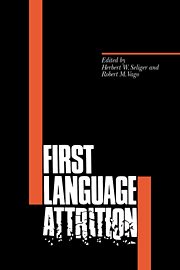Book contents
- Frontmatter
- Contents
- List of figures
- List of tables
- List of contributors
- Acknowledgment
- Part I Survey studies
- Part II Group studies
- Part III Case studies
- 12 Morphological disintegration and reconstruction in first language attrition
- 13 Assessing first language vulnerability to attrition
- 14 Compensatory strategies of child first language attrition
- 15 Language attrition, reduced redundancy, and creativity
- 16 Paradigmatic regularity in first language attrition
- Index
16 - Paradigmatic regularity in first language attrition
Published online by Cambridge University Press: 14 January 2010
- Frontmatter
- Contents
- List of figures
- List of tables
- List of contributors
- Acknowledgment
- Part I Survey studies
- Part II Group studies
- Part III Case studies
- 12 Morphological disintegration and reconstruction in first language attrition
- 13 Assessing first language vulnerability to attrition
- 14 Compensatory strategies of child first language attrition
- 15 Language attrition, reduced redundancy, and creativity
- 16 Paradigmatic regularity in first language attrition
- Index
Summary
Introduction
This chapter is concerned with the role of paradigmatic coherence in the attrition of a first language morphophonemic system in the context of bilingualism. It aims to characterize paradigm-internally induced changes in formal terms, specifically, as instances of rule simplification, rule reordering, rule loss, and lexical restructuring. The primary motivation underlying these structural innovations is claimed to be derived from two basic principles: reducing allomorphic variation and minimizing rule opacity. Both strategies maximize paradigmatic regularity.
The empirical data for this study were obtained from a thirty-six-year-old Hungarian–Hebrew bilingual Israeli woman who was born in Hungary and immigrated with her parents to Israel at age 5;10. The subject's primary language was Hebrew (L2); her usage of Hungarian (L1) was severely limited, confined almost exclusively to conversations (several times a week) with her parents, for whom Hungarian remained the preferred and dominant language of communication.
The Hungarian attrition data were gathered and analyzed in two stages. The methodology employed in the first stage was paradigm elicitation. In tape recorded interviews conducted in Hungarian by the present investigator, the subject was supplied individual nominal and verbal stems and was instructed to provide the various inflections that constitute paradigmatic sets in Hungarian. The information thus obtained was then analyzed and compared with the respective facts in the standard dialect of Hungarian. Independent investigation confirmed that there were no significant differences between the Hungarian spoken by the subject's parents and the standard dialect of Hungarian as concerns the inflectional phonology and morphology.
- Type
- Chapter
- Information
- First Language Attrition , pp. 241 - 252Publisher: Cambridge University PressPrint publication year: 1991
- 3
- Cited by



